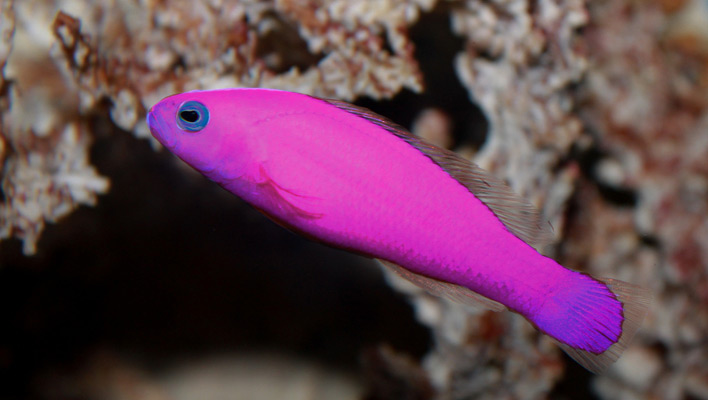Despite their diminutive size, many of the dottybacks have a well-deserved reputation for aggression. In fact, some species, such as the royal dottyback (Pictichromis paccagnellae), are so belligerent that it can be difficult to match them with suitable tankmates, as even much larger fish may be targets of their hostility.
Yet there are certain species among the dottybacks that are somewhat more peaceful in disposition and more inclined to “play nice with others.” One of these is the magenta, or strawberry, dottyback (Pictichromis porphyrea—formerly Pseudochromis porphyreus) from the Western Pacific.
Still no shrinking violet
Now don’t get me wrong; while P. porphyrea isn’t quite as belligerent as some of its congeners, it’s still all dottyback and by no means a pacifist. It is prone to attacking tankmates that are similar in shape, size, color, or habits, especially more peaceful species introduced to the tank after it. Observing proper order of introduction is definitely important with this species!
I once had an established specimen that relentlessly pursued a newly introduced Falco’s hawkfish (Cirrhitichthys falco) that attempted to occupy the same region of the tank. I thought the two might eventually sort things out, but that was just wishful thinking. The poor hawkfish ultimately leapt to its death through a little gap in the aquarium cover.
However, P. porphyrea will usually coexist with dissimilar, moderately aggressive species that aren’t easily cowed and don’t encroach to any significant extent on its territorial niche. Of course, P. porphyrea being a bite-size species, large, predatory fishes with a maw large enough to swallow a dottyback should be excluded as tankmates.
Physical characteristics
P. porphyrea is a small, slender fish, reaching only about 2½ inches in total length. As its common name suggests, it’s a gorgeous magenta in overall color, though it may appear more bluish in natural sunlight or under certain artificial lighting schemes.
Aquarium fare
Feeding is seldom a challenge with P. porphyrea. Its natural diet consists primarily of small benthic crustaceans (which should raise a red flag that small ornamental crustaceans kept in the same tank are at risk of becoming lunch), but aquarium specimens will usually accept most suitably sized meaty foods—mysids, chopped seafoods, frozen carnivore formulations, etc.
Proper housing
Owing to its small size and tendency to stay close to a chosen refuge, P. porphyrea is suitable for relatively modest-sized aquariums in the range of 20 to 30 gallons. Keep in mind, however, that the smaller the tank (i.e., the more compressed its territory), the more challenging it becomes to keep the magenta dottyback with other species. If kept in a nano system, it would likely need to be the lone fish occupant.
Aquascaping should include ample rockwork, not only so the dottyback is sure to find a nook that suits its fancy, but also to provide plenty of refuges for tankmates that might need to evade its line of sight and possible wrath.
The magenta dottyback is generally considered a good candidate for reef systems, demanding little in the way of open swimming space and being totally inoffensive to corals and other sessile invertebrates.



